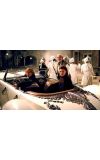
23 Jun 2012 01:48:23
Comic book legend Alan Moore is courting the wrath of Harry Potter fans after giving the long-awaited antichrist in his League of Extraordinary Gentlemen books a remarkable resemblance to the boy wizard.
The popular comic book series has traced the adventures of Mina Murray, Allan Quatermain and others, referencing everything from Brecht's Threepenny Opera to Rosemary's Baby and the Rolling Stones as the League journeys through history. In the heavily embargoed Century 2009, out this week, they arrive in the present day, where they are facing apocalypse and the foretold birth of the antichrist – who, it turns out, has a hidden scar and a mentor named Riddle.
While Moore, the author of the seminal graphic novels Watchmen and V for Vendetta, never uses the words Harry or Potter in Century 2009, he makes his allusions clear by portraying a magical school reached by a magical train hidden between platforms at London's King's Cross, according to reviewer Laura Sneddon, who blogs as Comicbookgrrrl and who got her hands on the only review copy. The magical school, however, appears nothing like Hogwarts: "There are flashbacks of psychotic adolescent rage and whimpering children pleading for their life, all strewn with molten corpses", writes Sneddon in a review for the Independent on Sunday, while the antichrist figure himself is "overgrown and high on anti-psychotics, raging at the education system that let him down and sounding peculiarly like Harry Enfield's teenage Kevin". At one point he even kills someone with a lightning bolt from his penis, according to the review.
In an interview with the Guardian on publication of the previous book in the series, Century 1969, last year, Moore said that the 21st-century storyline was drawn from a "much bleaker cultural landscape". "When we start out in 1910 we have a fairly rich background to draw from – we've got Brecht's Threepenny Opera which was set around that time, we've got all of those wonderful occult characters that were being created around then. By the time we get to 1969 we've got some equally interesting characters but they're a kind of different category. They're more often drawn from popular culture, because of course popular culture has expanded incredibly in the 50 years since 1910 when culture was still largely the preserve of an educated elite," he said. "But changes in society over the first 50 years of the century meant that by the middle years culture had changed, certainly by 1969 where pop culture was predominant and previous culture was perhaps in danger of becoming increasingly marginalised. And by the time we return to the League story in 2009, it's a much bleaker cultural landscape still."
Potter fans are likely to be angered by the portrayal of their bespectacled hero as "the magical child whose ominous coming has been foretold for the past hundred years" and who is now about to unleash "his promised aeon of unending terror", starting with north London.
But Sneddon, who called Moore "perhaps the greatest comic writer of our time", said that the author was "always keen to point out that the League books are satire and that he has respect for all characters that he uses and hints at, expressing hope that people will look beyond the Harry Potter connection to appreciate the whole".
"Make no mistake, the wily Moore is in no way making a statement on one character by his crafting of the ultimate bad guy in his series to date, rather his chosen antichrist is a commentary on a perceived degradation of society, both in our world and the fictional. As the publishing industry takes less risks, originality is visibly dwindling, while major franchises and celebrity biographies are relentlessly pushed upon us," said Sneddon. "When the antichrist comes face to face with the one character who can terminate his domination, it's difficult not to feel a swell of love for the old books that we all hold dear. People will perhaps be keen to paint this as a curmudgeonly assault on the popular Harry Potter, painting him as an evil abomination that has corrupted our children and heralded the death knell of children's fiction, but that is a shallow reading of a complex series that delights in layering meanings and references in the playground of our imagination."
Moore told the Guardian last year that the series was unlikely to end with Century 2009, leaving the door wide open to future controversies, including a tale set in 2011 and even stories set in the future. "Of course there are, as well as the fictional histories of periods like the Victorian era, there are also enormous quantities of stories written about the future. So the fictional universe reaches back in time but it extends forward, and it would be nice to be able to explore the basic concept of the League in that kind of territory as well," he said.

